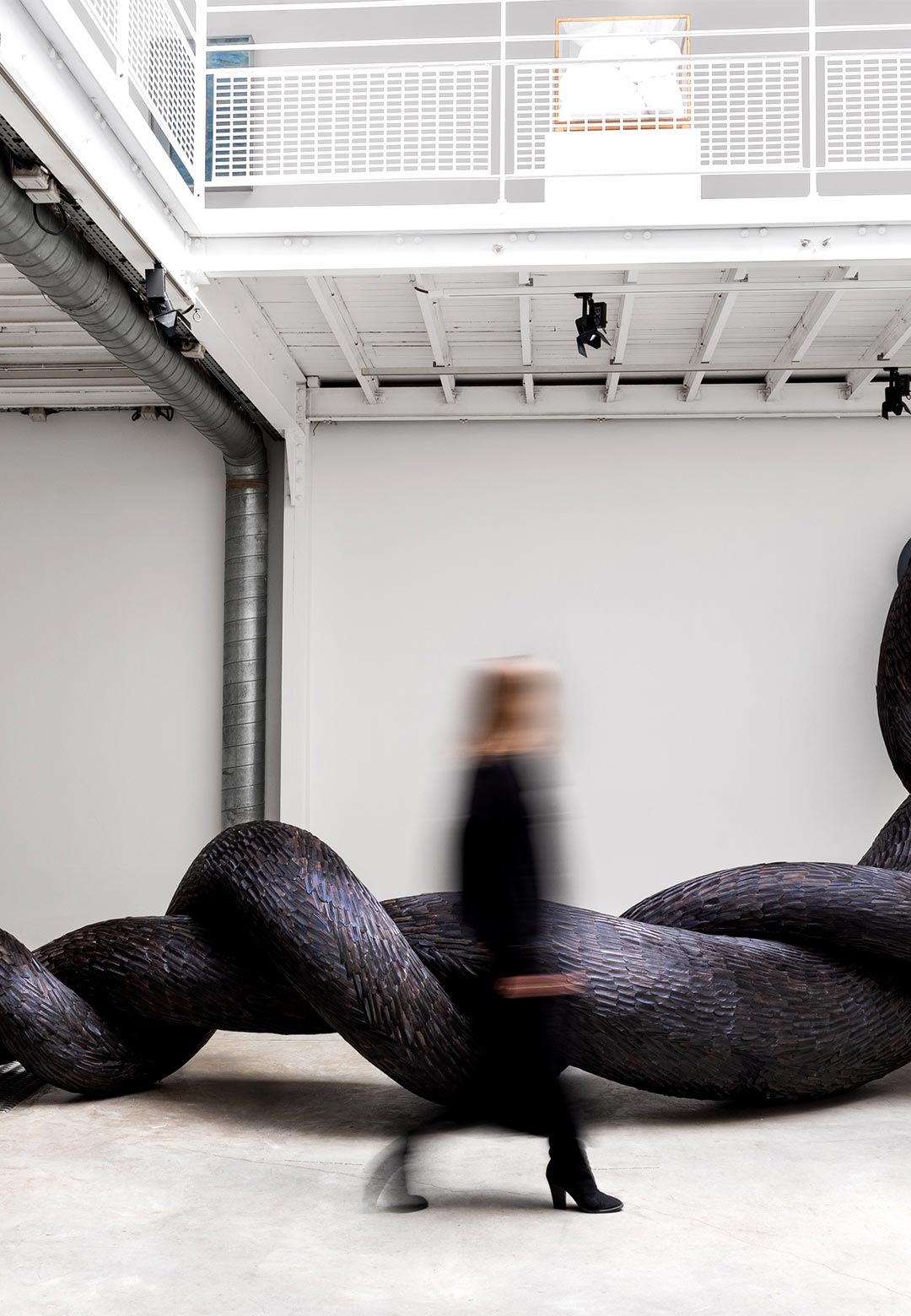“I grew up on the Norfolk Broads, constantly on the water, surrounded by birds and nature, which captivated me,” British artist Kate MccGwire tells me, when enquired about the inceptive experiences that helped shape her craft. “My family always used to say that I ‘noticed more’ than everyone else. I was constantly looking and observing the minutiae of my surroundings; the bird in the hedgerow, the ripples on the water or the patterning on a feather,” she adds, divulging a few details about her childhood spent in UK’s largest nationally protected wetland. MccGwire now resides in London, where she employs feathers as the primary medium for building lavishly sized and richly textured sculptures.
However, MccGwire’s entry into the world of art was not straightforward or entirely effortless. “My family was always supportive of my passion for drawing. Nevertheless, they were quite nervous and unhappy about me pursuing a Fine Arts degree, and sadly, would only support me if I studied a vocational subject that would lead directly to gainful employment (Interior Design at Manchester). So, I had to wait another ten years before I could follow my true passion and return to university and study Fine Arts (a five-year course), as a mature, part-time student with two young children. I went on to do an MA at the RCA for two years, and finally graduated in 2004, at the age of 40!” she reveals.
Upon witnessing the scale and form of MccGwire’s sculptures and the tenacity with which they stand, one finds it difficult to surmise, that they are produced using entities as light and delicate as feathers. Upon closer inspection, a perceivable smoothness marks their surfaces. The sculptor's works explore and frame various dualities. Their forms beckon the viewer towards them, while, at the same time, their snake-like configuration impels fear. The undulations writ by the artist simultaneously sit under the accreditations of abstract and organic art. Their textures confound the mind, with an appearance that sometimes seems in motion and at other times, static. These dualities mirror the dichotomies that exist in nature, and which, the artist perceived and interacted with, in the formative years of her life.
MccGwire cites her creative inspirations, “My work is inspired by nature, mythology, movement, and the uncanny. Things like the patterning of the water, the structure of a bird’s wing and the dualities of nature are some phenomena that I find constantly fascinating. For instance, the Thames: everything is fleeting on the water, it is beautiful, but there is danger and treachery underneath the surface. I am intrigued by that dichotomy.”
MccGwire collects, washes, sorts, grades, trims and then preps the feathers to build her pieces. Earlier, the artist would find these feathers on her daily walks with her dog Tilly and would collect them for sheer joy. However, upon her graduation from the Royal College of Art in 2004, MccGwire discovered a colony of pigeons in a warehouse on a battered down island on the Thames in South London. This encounter with a plethora of birds and their fallen feathers prompted MccGwire to begin this collection on a larger scale. Later, the artist began using these entities as the primal materials for her sculptures. Today, she sources feathers from all over the country, from pigeon racers, gamekeepers, as well as members of the general public. “Choosing to collect materials that you cannot actually buy, which are essentially by-products that would usually be discarded, is challenging and creative in its own right—the collaborative process of describing and persuading someone to have faith in my project and then be willing to give me their time and materials is integral to the process,” the sculpture artist asserts.
The sculptural artist’s process begins on paper—she begins by sketching out the forms of the sculptures she intends to build. Using a piece of charcoal to play around with different shapes and configurations helps MccGwire envision what would have been more complicated if executed directly with physical materials from the onset. Once an idea has been conceived and the desired feathers collected, MccGwire freezes the raw materials, cleans them, and then sorts them on the basis of their sizes, shapes and colours. “When feathering, I lose myself in the process for hours, working instinctually—you can't exactly plan how to lay the feathers out, nor can you really teach someone. Each precise placement of these feathers contributes to the overall energy of a piece and its implicit sense of movement, which gives verisimilitude to the work and brings it to life. There’s something about reusing and breathing new life into these materials that really resonates with me. This final stage draws on the rituals of craft, on the connection between hand and eye and the natural serendipity that happens when you become fully immersed in giving life to an idea,” she elaborates, delving into her creative process of building these sculptures. Some of the feathers used by the artist include those of a rooster, goose, pheasant, magpie, pigeon, and crow, among others.
Although the artist’s primary material of choice is feathers, she intends to incorporate the usage of several other kinds of entities as well as crafting techniques in order to conceive articles of sculptural art that are more dynamic. MccGwire also reveals that she intends to learn sixty new skills, such as welding, pottery, weaving, silver-smithing, wildlife photography, and more, in order to celebrate her 60th birthday next year. With the intention of immersing herself further in the making process, she believes that employing different modes of creation is imperative. Having recently incorporated sections of discarded copper into a sculpture, MccGwire understands the importance of adding new layers to one’s work. She intends to take a turn in her creative journey—a turn towards a new, more spirited journey.






 Sign in with email
Sign in with email










What do you think?